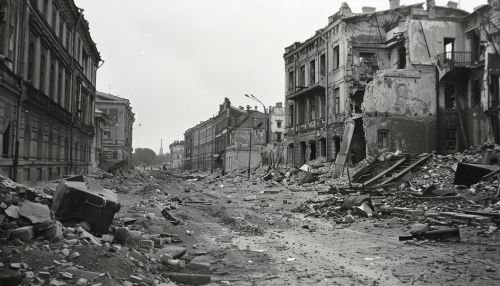Siege of Leningrad
Siege of Leningrad
The Siege of Leningrad, also known as the Leningrad Blockade, was a prolonged military blockade undertaken by the German Army Group North against Leningrad (now Saint Petersburg) during World War II. The siege began on September 8, 1941, and lasted until January 27, 1944, making it one of the longest and most destructive sieges in history and one of the costliest in terms of casualties.


Background
The strategic importance of Leningrad was immense due to its industrial capacity, its status as a major Soviet city, and its symbolic significance as the cradle of the Russian Revolution. The German invasion of the Soviet Union, known as Operation Barbarossa, commenced on June 22, 1941. The primary objective of the German Army Group North was to capture Leningrad, thereby crippling Soviet industrial capabilities and morale.
Initial Stages
In the initial stages of the siege, German forces rapidly advanced through the Baltic States and reached the outskirts of Leningrad by late August 1941. The Finnish Army, aligned with the Germans, advanced from the north, effectively encircling the city. By September 8, 1941, the last road to the city was severed, initiating the full blockade.
Conditions During the Siege
The conditions within Leningrad deteriorated rapidly. The city's food supplies were critically low, and rationing was introduced. The daily rations for civilians were reduced to as low as 125 grams of bread per day during the harsh winter of 1941-1942. The lack of food, coupled with the extreme cold, led to widespread starvation and death. It is estimated that over one million civilians perished during the siege.
Military Operations
Throughout the siege, the Soviet Red Army launched several operations to break the blockade. The most significant of these was the Sinyavino Offensive in 1942, which aimed to cut off the German forces. Although initially unsuccessful, these operations kept the German forces engaged and prevented them from reinforcing other fronts.
The Road of Life
One of the critical lifelines for the besieged city was the "Road of Life," a supply route across the frozen Lake Ladoga. During the winters, trucks transported food, fuel, and other essential supplies into Leningrad, while evacuating civilians. This route was perilous due to constant German air attacks and the treacherous ice conditions.
Breakthrough and Liberation
The siege was finally broken during the Leningrad-Novgorod Offensive, which began in January 1944. Soviet forces launched a series of coordinated attacks, eventually pushing the German forces back and lifting the blockade on January 27, 1944. The liberation of Leningrad was a significant morale boost for the Soviet Union and marked a turning point on the Eastern Front.
Aftermath
The aftermath of the siege saw Leningrad in ruins, with a devastated population. The city's infrastructure was heavily damaged, and the survivors faced the daunting task of rebuilding. The Soviet government awarded Leningrad the title of "Hero City" in recognition of the extraordinary resilience and sacrifice of its inhabitants.
Legacy
The Siege of Leningrad remains a symbol of Soviet endurance and resistance. It is commemorated annually in Russia, and numerous monuments and memorials have been erected in honor of those who suffered and perished. The siege has also been the subject of extensive historical research, literature, and film.
